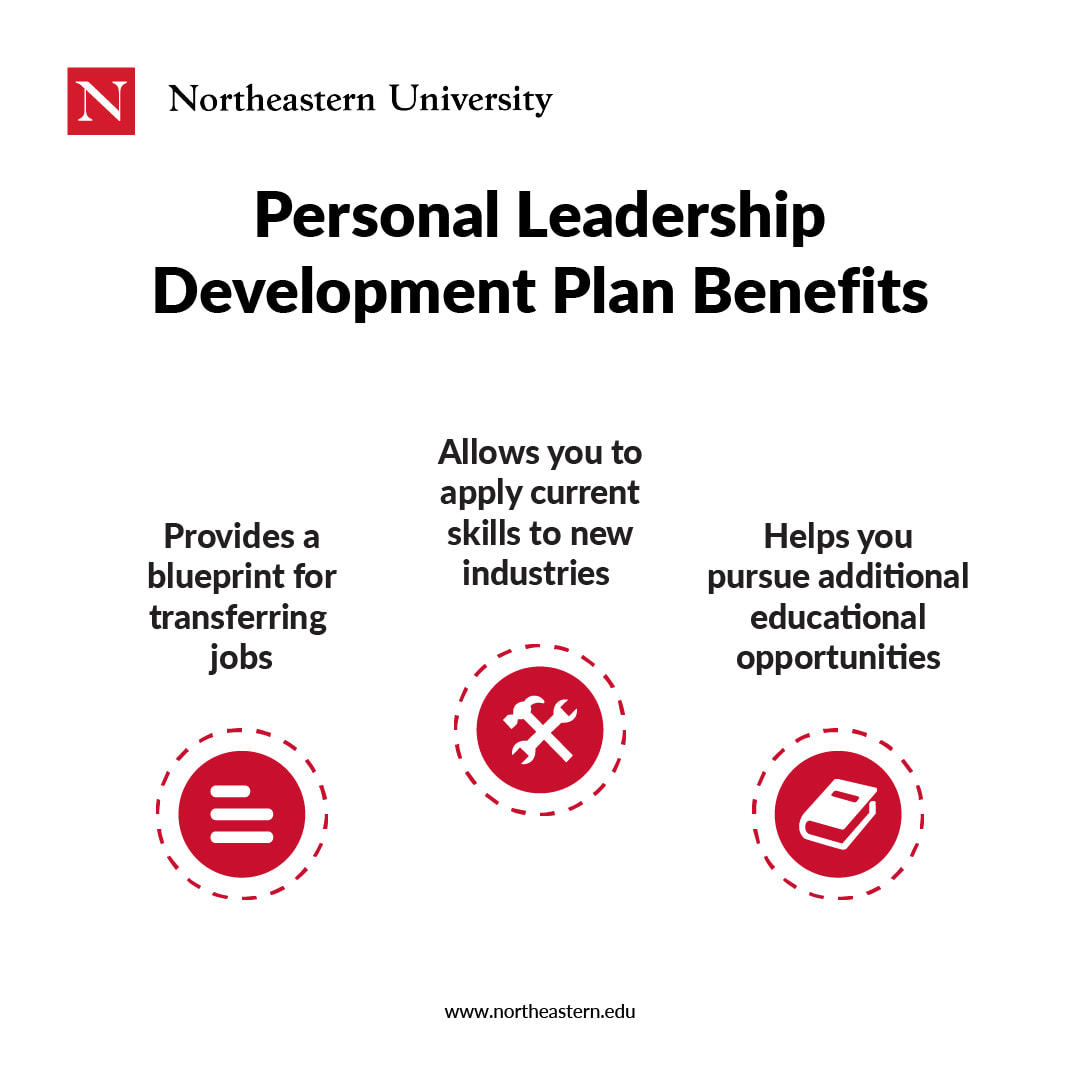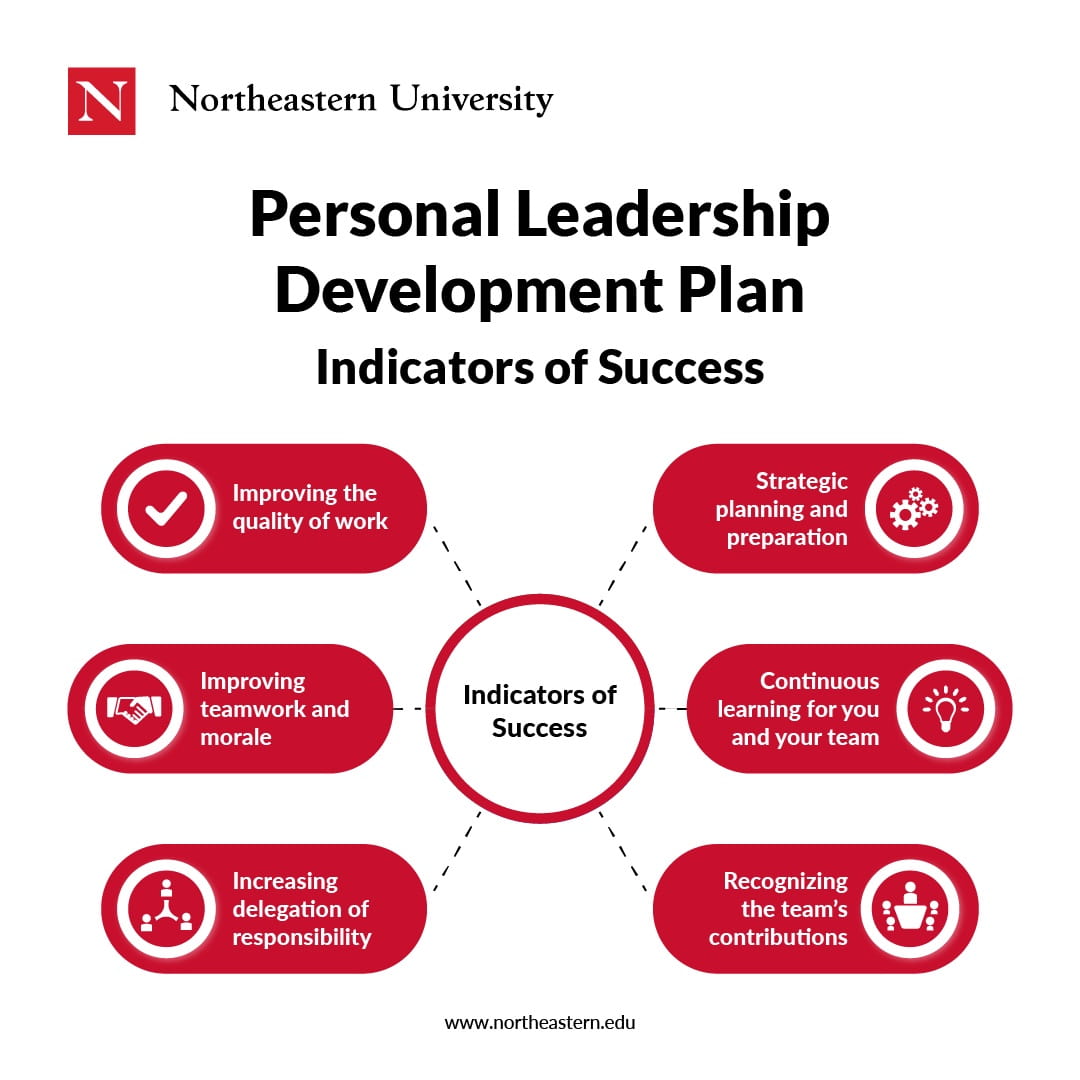In every organization and in every industry, leaders play a critical role: managing teams, working together to make important (and sometimes difficult) decisions, and guiding an organization to move in the right direction. While you might think of a leader as an experienced executive with a corner office, the reality is that successful organizations rely on employees who demonstrate strong leadership skills regardless of their job title or length of tenure.
If you are looking to enhance your leadership capacity, one important strategy for guiding your growth is to create a personal leadership development plan. This type of plan can help you grow in your current role and also prepare you to take on additional leadership responsibilities in a new role.
Here’s a quick look at how to assess your leadership skills, develop your leadership capabilities, create a personalized plan, and build leadership development into your everyday roles and responsibilities.
Learn More about Northeastern’s Bachelor of Science in Management Program
Get the leadership skills you need to advance your organization and your career.
Benefits of a Personal Leadership Development Plan
As the name implies, a leadership development plan outlines the steps that you intend to take in order to be a better leader. A plan should include skills you need to improve, responsibilities you want to take on, and tasks that you hope to complete to become the type of leader your organization needs.
Development plans are a critical tool for personal career growth since they serve as agreements between an employer and an employee. In these cases, the plan has benefits that extend beyond the individual. When leadership development is aligned with business strategy, organizations are able to link their investments in supporting potential leaders—such as internal training programs or tuition reimbursements—to broader goals and strategic plans. Such alignment increases the likelihood that your manager and other stakeholders within the organization will give your personal leadership plan the stamp of approval.
Of course, individuals can also create their own personal leadership development plans. This type of plan can be helpful if you hope to get a new job at a different company, apply your current skills to a new industry, or pursue educational opportunities, such as a degree completion program.

Before the Plan: Conducting a Self-Assessment
Prior to creating your personal leadership development plan, the American Management Association recommends that you make a list of what you feel are the 10 to 15 characteristics of an effective leader. Some of these traits should be specific to your current or desired industry or role, while others should apply to leadership in general.
Creating this list of leadership qualities will help you assess your own skills. Some of the characteristics on the list may require both professional and personal growth and are therefore worth including in your development plan. Other traits may be core strengths that are worth noting in your plan but will be a low priority for further development. Successful leaders tend to have many qualities in common, so it should be easy to identify which traits are a strength for you and which traits will require some improvement.
GovLeaders.org, a resource for managers and leaders in the public sector, suggests that you think about a “life mission statement.” Similar to a corporate mission statement, this is meant to link your leadership development efforts with your long-term personal and professional goals. This is an important step, as it ensures that the steps you take to improve your leadership skills do not conflict with the type of work that you want to do.
Elements of a Personal Leadership Development Plan
After you have given some thought to your long-term leadership goals and the leadership qualities you’d like to improve, it’s time to map out your leadership ability by creating your personal leadership development plan.
Since the document is personal, it should take on the style and format that works best for the way that you take in information. Some people may use a spreadsheet; others may prefer a chart. No matter the format, there are several key things that every personal leadership development plan should include:
1. Core Skills to Master
Leaders have a number of job responsibilities that are specific to a role as a supervisor. These can include running meetings, providing feedback, sharing information in front of groups, and making personnel decisions. Identify the skills that align with your leadership development goals but are not part of your existing job responsibilities. If someone you currently work with has these skills, ask if you can shadow them or practice with them. If not, look for external resources that will help you build these skills.
2. Experience Gaps to Close.
In addition to tactical skills, there are a number of strategic responsibilities that a leader can expect to take on. These can include starting a new project, turning around a project that is not going well, managing larger and more mission-critical projects, and managing in a crisis. As with building skills, it’s important to identify these key tasks that align with your goals and develop a plan to gain the necessary experience.
3. New Relationships to Build
As a leader, you interact with a variety of stakeholders on a regular basis. Many are within your organization and include department heads, front-line employees, and managers with different skill sets but similar tenure. Others are outside your organization and range from customers and suppliers to board members and other members of the business community. As you build a leadership development plan, identify the stakeholders with whom you’d like to have a stronger, mutually beneficial relationship and reach out to start the conversation. Making these important connections is essential for effective leadership since they provide more development opportunities.
4. Specific Tasks to Delegate
Effective leaders strike a balance between day-to-day tasks and long-term responsibilities. They focus on the work that is most closely aligned with their expertise and trust others within the organization everything else, ensuring that projects are not delayed and that employees remain engaged. List the activities that are critical to professional development within your role, along with the activities that others are capable of completing themselves.
5. Key Action Items to Complete
As noted, the specifics of a leadership development plan should include strengths as well as potential areas of improvement. For each area where you see potential to improve, include an action item, the timeframe in which you want to complete the task, and the cost (in time and/or money). Action items could include meeting with a mentor or manager, reading a book on leadership, completing a leadership assessment, or identifying training or educational opportunities.
6. Critical Indicators of Success
Leaders are assessed not only on their own success but also on the success of their teams. Your personal leadership development plan should list the critical indicators of success for leaders and their teams, which include but are not limited to the following:
- Improving the quality of work
- Improving teamwork and morale
- Increasing delegation of responsibility
- Strategic planning and preparation
- Continuous learning for you and your team
- Recognizing the team’s contributions

Beyond the Plan: Building Leadership Development into your Role
A personal leadership plan should be a living document. You should revisit it on a regular basis to ensure that you are addressing the areas of improvement that you identified for yourself and meeting the timelines you set for taking on new responsibilities, building new skills, and so on.
Accomplishing the goals that you lay out in your plan should not require wholesale changes to how you work or learn. After all, the plan is meant to help you continue to grow, not start over completely. However, there are a few activities that you can add to your regular routine to support your development as a leader.
Seek feedback. Talk to your team and your peers about how well you are growing as a leader and where you can continue to make improvements. It’s also important to seek feedback from groups you don’t typically interact with, whether they be other divisions within your organization or third-party partners. These groups will provide different insight than those who work with you regularly.
Take time to reflect. Leaders have a great deal of responsibility to juggle. Take 15 minutes every morning to assess the most important tasks for the day and 15 minutes in the evening to reflect on what went well and what could have been improved. Consider writing your thoughts in a journal, focusing on lessons or insights you have gained from your experience.
Find a mentor. Whether as a source of advice or as a connection to networking opportunities, mentors are critical to personal leadership development. It’s important to find a mentor who will be available for regular meetings and who will provide honest feedback—someone who always tells you what you want to hear may inadvertently hinder your growth. Your mentor could be a manager at your current job, a manager from a previous job, a professor, or a respected figure from your personal life.
Sign up for training. Continued education provides a valuable opportunity to nurture leadership skills. In addition to resources such as books, networking events, and leadership retreats, consider earning a bachelor’s degree to hone a wide range of skills—including psychology, writing, negotiation, finance, ethical decision-making, logic, and organizational behavior.
Interested in learning more about how a bachelor’s degree can help advance your career and refine your skills? Explore Northeastern’s Bachelor of Science in Management program to learn more.
